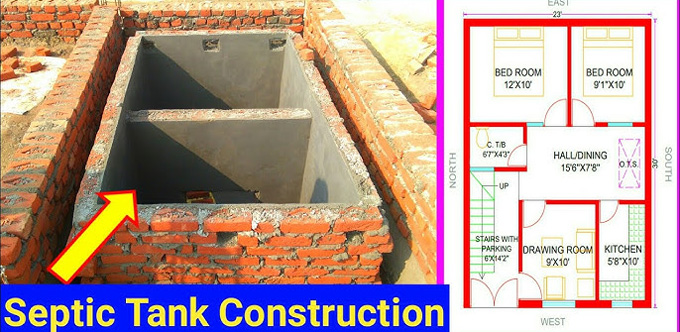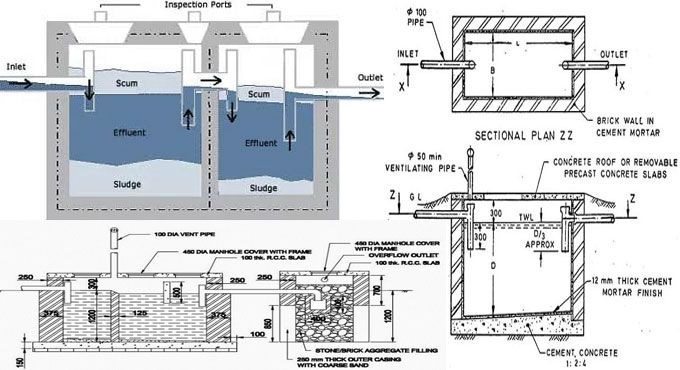
Septic Tank: Types, Design, Size, Advantages & Disadvantages

The septic system in the household is necessary to treat the wastewater of the house. The wastewater that has been generated from the household, including the bathrooms, laundry rooms and kitchen, can be treated by the household’s septic system. The building property and the surrounding environment have been protected from the harmful contaminants by installing the septic system.

The septic tank should be strong enough to resist the movement of the earth and should not leak. It also needs to be considered that the septic tank should hold a metric ton of liquid waste for each cubic metre. Either plastic or reinforced concrete can be used to construct the septic tank, which helps to resist the ground movement. In the septic tank, there should be at least two chambers.
Different components of the septic system in the building structure
Different components are required for designing and constructing the septic system in the building structure, which are as follows:
Septic Tank
In the septic system of a household, the septic tank is one of the crucial parts. The septic tank is buried under the ground and helps to hold and treat the wastewater of the household. The solid and scum part within the wastewater can be separated with the help of the septic tank. This feature helps to allow the waste to break down naturally by bacteria.
Drain Field
The drain field is another important part of the septic system in the household, through which the treated wastewater is released into the ground from the septic tank. The contaminants in the wastewater are filtered out by the soil before the water goes to the groundwater system.
Soil Absorption System
The soil absorption system works along with the drain field in the conjunction area. The liquid part of the wastewater of the building structure can be treated by the soil absorption system of the septic system. The microbes help to break down the harmful substances in the wastewater while passing through the soil layer.
The reason behind designing the septic tank
There are several uses of a septic tank, which influence the necessity of the septic tank in the building structure.
➢ The septic tank has been designed into the building structure to discard the foul sewage from the building. On the other hand, the sullage waste of the building has been distributed to the garden or grass areas, which have been dispersed and absorbed or drained into the sewage pit. These types of waste have been absorbed by the surrounding soil.
➢ For accessing the sewage lines, the construction of the septic tank is necessary.
➢ In the case of the rural areas, the septic tank helps to manage the wastewater of the household.
➢ The installation of a septic tank is also necessary in the case of a house that has a poor drainage system or has a high water table.
Requirements for septic tank construction
Regulations
The builders need to ensure that the construction process of the septic tank complies with the local standards. The owner required permission from the local authorities before the construction of the septic tank. In this context, the building owner should have to submit the site plan and the soil test results to the local authorities to get permission for the construction of the septic tank.
Inspection of the construction site and testing the soil
The inspection of the construction site is essential before the septic tank construction at that site. It needs to be ensured that the wastewater is absorbed and filtered by the soil at the construction site. The wastewater absorption ability of the soil can be determined by performing the percolation test. In addition, this test also estimates the appropriate cost of the septic tank construction.
Determining the tank size
The size of the septic tank depends on the amount of water that is used daily in the household.
Cost factors that need to be considered when designing a septic tank
There are several factors that influence the design and construction cost of the septic tank, which are as follows:
Costs for materials
The construction of the concrete septic tank is more costly as compared to the fibreglass septic tank or plastic septic tanks. In the case of using cheaper materials in the septic tank construction, there is a more frequent requirement for the repair or replacement of the septic tank.
Cost of installing the tank
The excavation procedure at the construction site, the site preparation procedure and the labour costs can influence the overall cost for installing the septic tank.
To learn more, watch the following video tutorial.
Video Source: Ian Construction
In the case of facing any difficulties in the installation process of the septic tank, more specialised equipment is required to install the septic tank, which can influence the overall cost of the septic tank construction.


